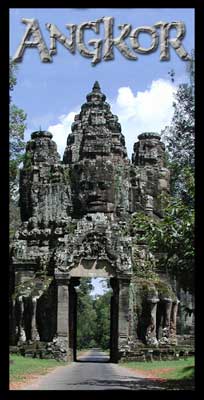 Click
on images for larger view.
Click
on images for larger view.
|
|
This
was my first experience with of the true "wonders of the world".
Indeed, this place, where history, art and architecture both struggle
and harmonize with the dense surrounding jungle, exceeds all expectations.
Collectively, the ruins known as Angkor contain over 40 accessible
sites amid some 80sq. miles (200sq.km.) of jungle, including temples,
terraces and gateways signifying the dominance of the Khmer civilization.
During the height of the Khmer rule, their kingdom included not
only the homeland of Cambodia, but most of modern-day Thailand,
Laos, and Vietnam. Many examples of Khmer architecture and design
can still be found in throughout these SE Asian countries, lasting
symbols of their wide influence.
The temples were constructed between 900-1500 AD, in various styles
and using a variety of materials including plaster, brick, stucco,
laterite (local mudstone), and sandstone. Most of the sandstone
used to build the temples came from one place, the Phnom Kulen mountains,
20 miles NE of Angkor near the Tonle Sap lake and river, and it
is hypothesized that the Khmer used these waterways in conjunction
with a series of manmade canals and moats to transport by raft the
millions of tons of stone necessary to build the temples. It's also
widely believed centuries of building the temples actually weakened
the Khmer, denying valuable resources needed to feed, house, defend
and maintain the rest of the empire, leading to their eventual downfall
as the leading kingdom of Indochina in the mid second millennium.
I found Angkor to be pretty much astonishing at every turn. Many
of the temples have been restored and strengthened against their
own decline to some degree, allowing one to get an idea of their
original grandeur. Others have been left to the jungle with minimal
renovation, allowing one to experience them virtually undisturbed
in their struggle with the forces of time.
|


